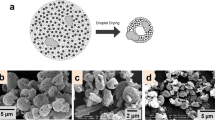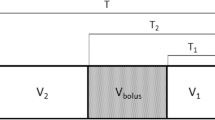ABSTRACT
Purpose
Study objectives were to develop, characterize, and evaluate a novel excipient for dry powder inhalation formulations in a canine model with a model compound.
Methods
Dry powder inhalation formulations of albuterol sulphate were developed and compared to a commercially available nebulizer albuterol solution formulation. In vitro analysis indicated a high fine-particle fraction (FPF, >70%) and a respirable particle size (∼2.5 µm MMAD). Each inhalation formulation, including controls, was delivered targeting a deposited lung dose of 10 µg/kg albuterol. Active formulations were evaluated for pharmacokinetic (PK) profile and bronchodilatory effects in a ragweed-sensitized dog model of allergic airway responses.
Results
In vitro, the dextran spray-dried formulated materials showed that aerosol performance, including FPF, MMAD, glass transition temperature, and amorphous characteristics, were all largely unaffected by amount of drug loaded. Both the commercial and the dry powder formulations attenuated the ragweed-induced bronchoconstriction by 91.59 ± 3.60 and 81.28 ± 9.29%, respectively. The PK profiles for both albuterol formulations were similar, as were the corresponding Tmax, Cmax and T1/2.
Conclusions
Results indicate that dextran 10 has promise as a novel excipient for dry powder inhalation drug delivery, in a preclinical setting, over a wide range of drug loadings.







Similar content being viewed by others
Abbreviations
- ANOVA:
-
analysis of variance
- APS:
-
Aerodynamic Particle Sizer
- COPD:
-
chronic obstructive pulmonary disorder
- DC:
-
dendritic cell
- DVS:
-
dynamic vapor sorption
- FPF:
-
fine particle fraction
- GSD:
-
geometric standard deviation
- HPLC-UV:
-
high-pressure liquid chromatography-ultra violet
- LC-MS-MS:
-
liquid chromatography tandem mass spectrometry
- LRRI:
-
Lovelace Respiratory Research Institute
- MDI:
-
metered dose inhaler
- mDSC:
-
modulated differential scanning calorimetry
- MMAD:
-
mass median aerodynamic diameter
- NGI:
-
Next Generation Impactor
- PK:
-
pharmacokinetic
- PSD:
-
particle size distribution
- PXRD:
-
powder X-ray diffraction
- RH:
-
relative humidity
- RW:
-
ragweed
- SEM:
-
scanning electron microscopy, standard error of the mean
- SPE:
-
solid phase extraction
- Tg:
-
glass transition temperature
REFERENCES
Mogalian E, Myrdal PB. Pharmaceutical solvents for pulmonary drug delivery, solvent systems and their selection in pharmaceutics and biopharmaceutics. New York: Springer; 2007.
Arturson G, Wallenius G. The intravascular persistence of dextran of different molecular sizes in normal humans. Scand J Clin Lab Invest. 1964;16:76–80.
Barrowcliffe MP, Zanelli GD, Ellison D, Jones JG. Clearance of charged and uncharged dextrans from normal and injured lung. J Appl Physiol. 1990;68:341–7.
Dubick MA, Wade CE, the HSD Development Group. Evaluation of the local irritation potential of hypertonic saline-dextran (HSD) in mice and rabbits. J Appl Toxicol. 2004;24:409–13.
Dubick MA, Wade CE. A review of the efficacy and safety of 7.5% NaCl/6% dextran 70 in experimental animals and humans. J Trauma. 1994;36:323–30.
PolyDex Pharmaceuticals Limited. Corporate Overview. Supportive Industry Partners. http://www.polydex.com/v2/company/corporate_overview.html (accessed 02 Feb 2010).
Wuillemin WA, te Velthuis HY, Lubbers YT, de Ruig CP, Eldering E, Hack CE. Potentiation of C1 inhibitor by glycosaminoglycans: dextran sulfate species are effective inhibitors of in vitro complement activation in plasma. J Immunol. 1997;159:1953–60.
Yahata T, Nishimura Y, Maeda H, Yokoyama M. Modulation of airway responsiveness by anionic and cationic polyelectrolyte substances. Eur J Pharmacol. 2002;434(1–2):71–9.
Redman TK, Rudolph K, Barr EB, Bowen LE, Muggenburg BA, Bice DE. Pulmonary immunity to ragweed in a beagle dog model of allergic asthma. Exp Lung Res. 2001;27:433–51.
Barrett EG, Rudolph K, Bowen LE, Muggenburg BA, Bice DE. Effect of inhaled ultrafine carbon particles on the allergic airway response in ragweed sensitized dogs. Inhal Toxicol. 2003;15:151–65.
Barrett EG, Rudolph K, Bowen LE, Bice DE. Parental allergic status influences the risk of developing allergic sensitization and an asthmatic-like phenotype in canine offspring. Immunology 2003;110:493–500.
Doyle-Eisele M, Kuehl PJ, Spindle RW, McDonald JD. Aerosol deposition of inhaled dry powder and nebulized albuterol in beagle dogs. Presented at AAAR Annual Conference, Minneapolis, MN, (Oct 2009).
Bide RW, Armour SJ, Yee E. Allometric respiration/body mass data for animals to be used for estimates of inhalation toxicity to young adult humans. J Appl Toxicol. 2000;20(4):273–90.
Wuillemin WA, Eldering E, Citarella F, de Ruig CP, ten Cate H, Hack CE. Modulation of contact system proteases by glycosaminoglycans. Selective enhancement of the inhibition of factor XIa. J Biol Chem. 1996;271:12913–8.
Laumonier T, Walpen AJ, Maurus CF, Mohacsi PJ, Matozan KM, Korchagina EY, et al. Dextran sulfate acts as an endothelial cell protectant and inhibits human complement and natural killer cell-mediated cytotoxicity against porcine cells. Transplantation 2003;76:838–43.
Banz Y, Cung T, Korchagina EY, Bovin NV, Haeberli A, Rieben R. Endothelial cell protection and complement inhibition in xenotransplantation: a novel in vitro model using whole blood. Xenotransplantation 2005;12:434–43.
Spirig R, van Kooten C, Obregon C, Nicod L, Daha M, Rieben R. The complement inhibitor low molecular weight dextran sulfate prevents TLR4-induced phenotypic and functional maturation of human dendritic cells. J Immunol. 2008;181(2):878–90.
Lukacs NW, Glovsky MM, Ward PA. Complement-dependent immune complex-induced bronchial inflammation and hyperreactivity. Am J Physiol Lung Cell Mol Physiol. 2001;280(3):L512–8.
Nilsson G, Johnell M, Hammer CH, Tiffany HL, Nilsson K, Metcalfe DD, et al. C3a and C5a are chemotaxins for human mast cells and act through distinct receptors via a pertussis toxin-sensitive signal transduction pathway. J Immunol. 1996;157:1693–8.
Stimler-Gerard NP, Galli SJ. Mast cells are not required for anaphylatoxin-induced ileal smooth muscle contraction. J Immunol. 1987;138:1908–13.
Schellenberg RR, Foster A. In vitro responses of human asthmatic airway and pulmonary vascular smooth muscle. Int Arch Allergy Appl Immunol. 1984;75:237–41.
Stimler NP, Hugli TE, Bloor CM. Pulmonary injury induced by C3a and C5a anaphylatoxins. Am J Pathol. 1980;100:327–38.
Baelder R, Fuchs B, Bautsch W, Zwirner J, Köhl J, Hoymann HG, et al. Pharmacological targeting of anaphylatoxin receptors during the effector phase of allergic asthma suppresses airway hyperresponsiveness and airway inflammation. J Immunol. 2005;174(2):783–9.
Mizutani N, Nabe T, Yoshino S. Complement C3a regulates late asthmatic response and airway hyperresponsiveness in mice. J Immunol. 2009;183:4039–46.
Nakano Y, Morita S, Kawamoto A, Suda T, Chida K, Nakamura H. Elevated complement C3a in plasma from patients with severe acute asthma. J Allergy Clin Immunol. 2003;112(3):525–30.
Author information
Authors and Affiliations
Corresponding author
Rights and permissions
About this article
Cite this article
Kuehl, P.J., Barrett, E.G., McDonald, J.D. et al. Formulation Development and In Vivo Evaluation of a New Dry Powder Formulation of Albuterol Sulphate in Beagle Dogs. Pharm Res 27, 894–904 (2010). https://doi.org/10.1007/s11095-010-0084-z
Received:
Accepted:
Published:
Issue Date:
DOI: https://doi.org/10.1007/s11095-010-0084-z




